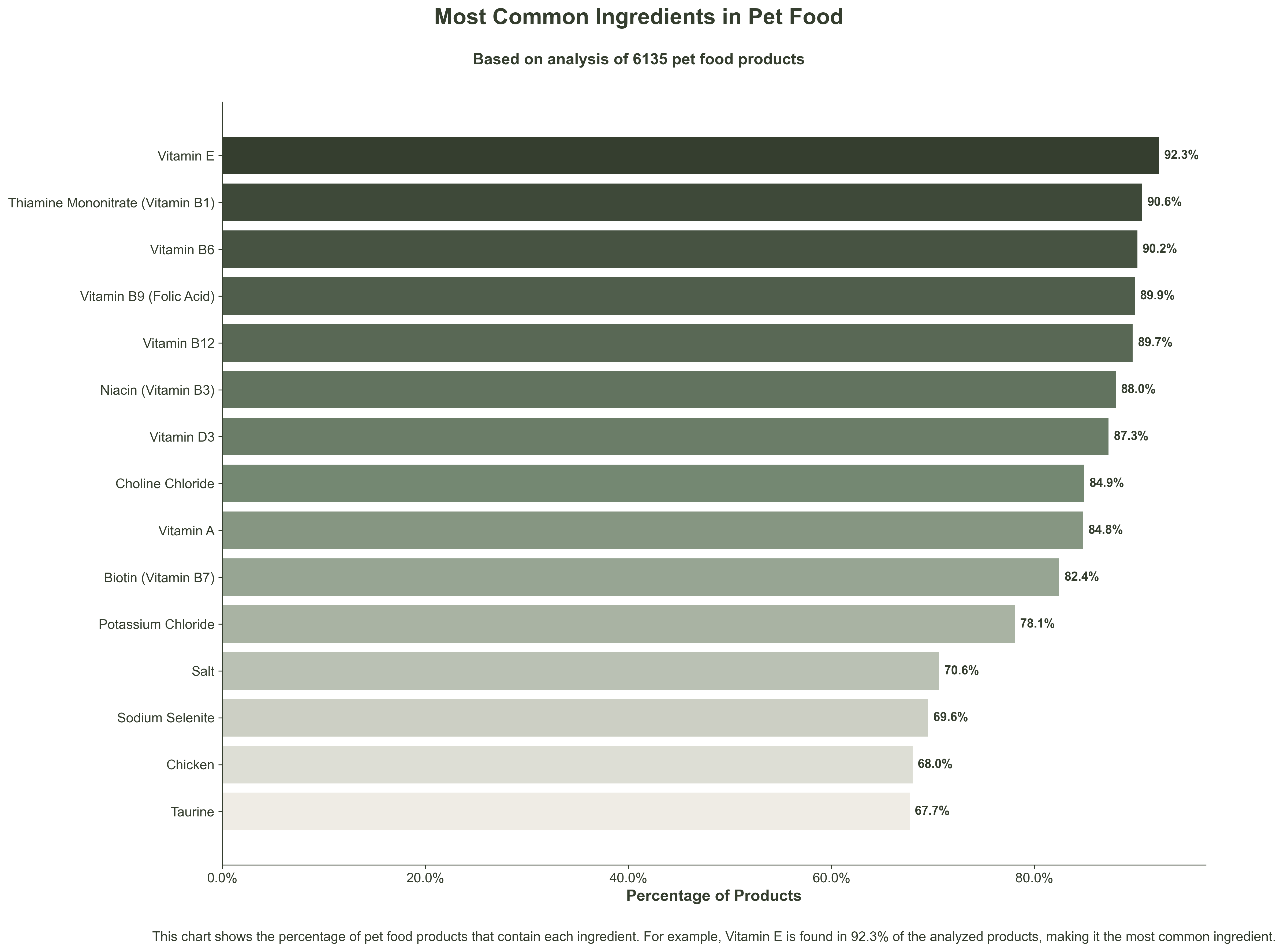- Our Comprehensive Pet Food Data Analysis
- Data Sources and Methodology
- Top 15 Most Frequent Ingredients in Dog and Cat Food
- Dry vs. Wet Pet Food: Ingredient Comparison
- Dog Food vs. Cat Food: Ingredient Comparison
- Key Highlights for Pet Owners
- U.S. Pet Food Market Insights
- What This Means for Choosing Your Pet's Food
- Stay Informed with KibbleLab
01. Our Comprehensive Pet Food Data Analysis
Our study examined a total of 6,135 pet food products, broken down as follows:
-
Types of food:
- Dry kibble: 2,641 (43.05%)
- Wet food: 3,494 (56.95%)
-
Species:
- Dog food: 3,217 (52.44%)
- Cat food: 2,918 (47.56%)
-
Detailed Breakdown:
- Dry cat food: 863 (14.07%)
- Wet cat food: 2,055 (33.50%)
- Dry dog food: 1,778 (28.98%)
- Wet dog food: 1,439 (23.46%)
02. Data Sources and Methodology
To ensure our analysis represents the current U.S. pet food market accurately, we sourced our data from three major pet food retailers. These retailers were selected for their extensive range of products, encompassing both popular and niche brands across various price points. By analyzing products from these major retailers, we've captured a comprehensive snapshot of the pet food options readily available to most American pet owners.
Our team manually verified and standardized the ingredient lists for each product to ensure accuracy in our analysis. This process involved cross-referencing ingredient information across multiple sources when available.
It's important to note that while this data provides valuable insights into common pet food ingredients, it may not represent every product available in the market, particularly regional or boutique brands not carried by these major retailers.
03. Top 15 Most Frequent Ingredients in Dog and Cat Food
Our analysis revealed the following as the top 15 most common ingredients across all 6,135 products:
- Vitamin E (5,661 products, 92.27%)
- Thiamine Mononitrate (5,560 products, 90.63%)
- Vitamin B6 (5,531 products, 90.15%)
- Vitamin B9 (5,515 products, 89.89%)
- Vitamin B12 (5,502 products, 89.68%)
- Niacin (5,401 products, 88.04%)
- Vitamin D3 (5,357 products, 87.32%)
- Choline Chloride (5,209 products, 84.91%)
- Vitamin A (5,202 products, 84.79%)
- Biotin (5,058 products, 82.44%)
- Potassium Chloride (4,791 products, 78.09%)
- Salt (4,332 products, 70.61%)
- Sodium Selenite (4,267 products, 69.55%)
- Chicken (4,173 products, 68.02%)
- Taurine (4,155 products, 67.73%)

Key Observation: Our data reveals that vitamins and minerals dominate the ingredient lists, reflecting the pet food industry's focus on creating nutritionally complete and balanced diets. Notably, chicken is the only whole food ingredient in the top 15, appearing in 68.02% of all products analyzed.
According to the Association of American Feed Control Officials (AAFCO), these added nutrients are essential for pet health. Learn more about AAFCO standards here [1].
04. Dry vs. Wet Pet Food: Ingredient Comparison
Our analysis shows distinct patterns when comparing dry and wet pet foods:
-
Dry Pet Food Top 5:
- Vitamin E (2,551 products, 96.59%)
- Vitamin B9 (2,524 products, 95.57%)
- Vitamin B6 (2,521 products, 95.46%)
- Vitamin B12 (2,513 products, 95.15%)
- Niacin (2,511 products, 95.08%)
-
Wet Pet Food Top 5:
- 1. Vitamin E (3,110 products, 89.01%)
- 2. Thiamine Mononitrate (3,050 products, 87.29%)
- 3. Vitamin B6 (3,010 products, 86.15%)
- 4. Vitamin B9 (2,991 products, 85.60%)
- 5. Vitamin B12 (2,989 products, 85.55%)
Key Insight: Both dry and wet pet foods show a similar vitamin profile in their top ingredients. However, thiamine mononitrate (Vitamin B1) appears more frequently in wet foods. This is likely because the heat processing used in canning can degrade natural thiamine sources, leading manufacturers to add synthetic thiamine mononitrate to ensure adequate levels. Read more about pet food processing methods in our article on pet food processing.
05. Dog Food vs. Cat Food: Ingredient Comparison
Our data reveals interesting differences between dog and cat food formulations:
-
Top 5 Cat Food Ingredients:
- Vitamin B9 (2,697 products, 92.43%)
- Taurine (2,691 products, 92.22%)
- Vitamin E (2,691 products, 92.22%)
- Vitamin B6 (2,686 products, 92.05%)
- Thiamine Mononitrate (2,636 products, 90.34%)
-
Top 5 Dog Food Ingredients:
- Vitamin E (3,006 products, 93.44%)
- Thiamine Mononitrate (2,946 products, 91.58%)
- Vitamin B12 (2,903 products, 90.24%)
- Vitamin B6 (2,858 products, 88.84%)
- Vitamin B9 (2,830 products, 87.97%)
Significant Finding: The most notable difference is the high prevalence of taurine in cat foods (92.22% of cat food products). This aligns with feline nutritional requirements, as cats, unlike dogs, cannot synthesize taurine and must obtain it from their diet. Taurine is crucial for cat health, supporting heart function, vision, and reproduction. Learn more about the importance of taurine for cats in our article on taurine in cat food.
06. Key Highlights for Pet Owners
- Vitamins and minerals dominate ingredient lists, reflecting the industry's focus on nutritional completeness.
- Chicken is the most common whole food ingredient, present in 68.02% of all products analyzed.
- Wet foods have a higher prevalence of thiamine mononitrate, likely due to processing methods.
- Taurine is a top ingredient in cat foods (92.22%) but doesn't appear in the top 5 for dog foods, reflecting the different nutritional needs of cats and dogs.
07. U.S. Pet Food Market Insights
Our analysis of products from major U.S. retailers provides a comprehensive view of the American pet food market. This data is particularly relevant for U.S. pet owners, as it reflects the products most readily available to them.
It's worth noting that the U.S. pet food industry is regulated by the FDA, with nutritional standards often set by AAFCO (Association of American Feed Control Officials). These regulations influence the ingredients and nutritional profiles we see in our analysis. For more info, check out our article on pet food regulation.
08. What This Means for Choosing Your Pet's Food
Our data-driven insights can help you make more informed decisions about your pet's nutrition:
- The prevalence of added vitamins and minerals (92.27% of products contain Vitamin E) suggests that most commercial pet foods are formulated to meet basic nutritional needs.
- If your pet has specific dietary requirements or sensitivities, pay close attention to the whole food ingredients, as these vary more widely between products.
- For cat owners, ensure your cat's food contains taurine (present in 92.22% of cat foods), especially if you're considering homemade diets.
- Remember that while these are the most common ingredients, they may not necessarily be the best for every pet. Always consult with your veterinarian about the best diet for your individual pet.
09. What This Means for Choosing Your Pet's Food
At KibbleLab, we're committed to providing data-driven insights into pet nutrition. We update our analyses annually to keep you informed about the latest trends in pet food ingredients.
Ready to find the perfect food for your furry friend? Try our Pet Food Search Tool to get personalized recommendations based on your pet's specific needs.
Remember, understanding what goes into your pet's food is a crucial part of responsible pet ownership. By staying informed, you can make the best choices for your pet's health and well-being.
Thank you for trusting KibbleLab as your source for pet nutrition information. We look forward to continuing to support you in your pet care journey with data-driven insights and analysis.
Key Takeaways
- This analysis of 6,135 products offers insights into current U.S. pet food trends and ingredient standards.
- Vitamins and minerals dominate pet food ingredients, with Vitamin E leading at 92.27% prevalence.
- Chicken is the most common whole food ingredient, found in 68.02% of products.
- Taurine is listed as an ingredient in 92.22% of cat foods, reflecting its importance in feline nutrition.
- Thiamine mononitrate appears more frequently in wet pet food ingredient lists compared to dry foods.

